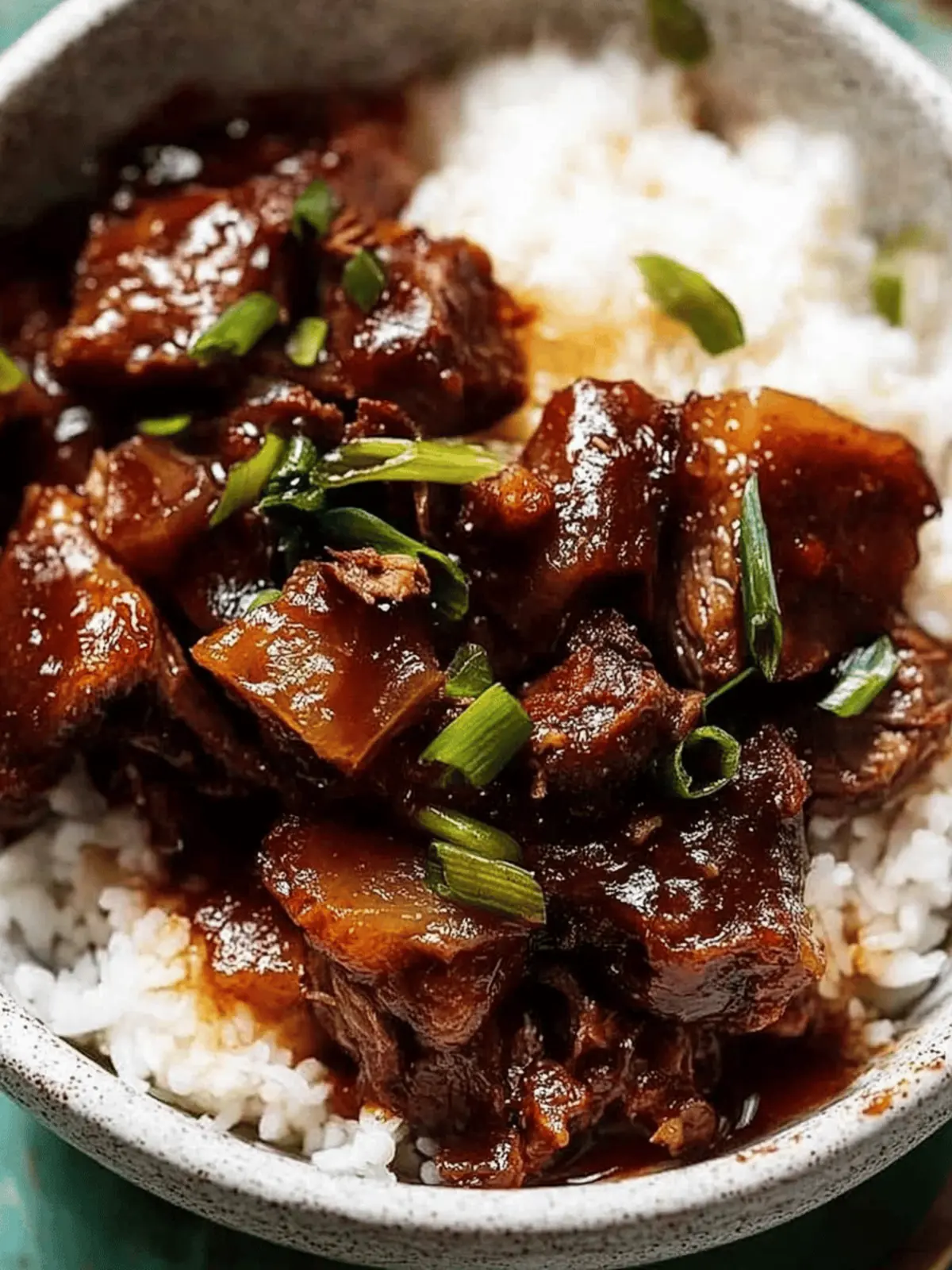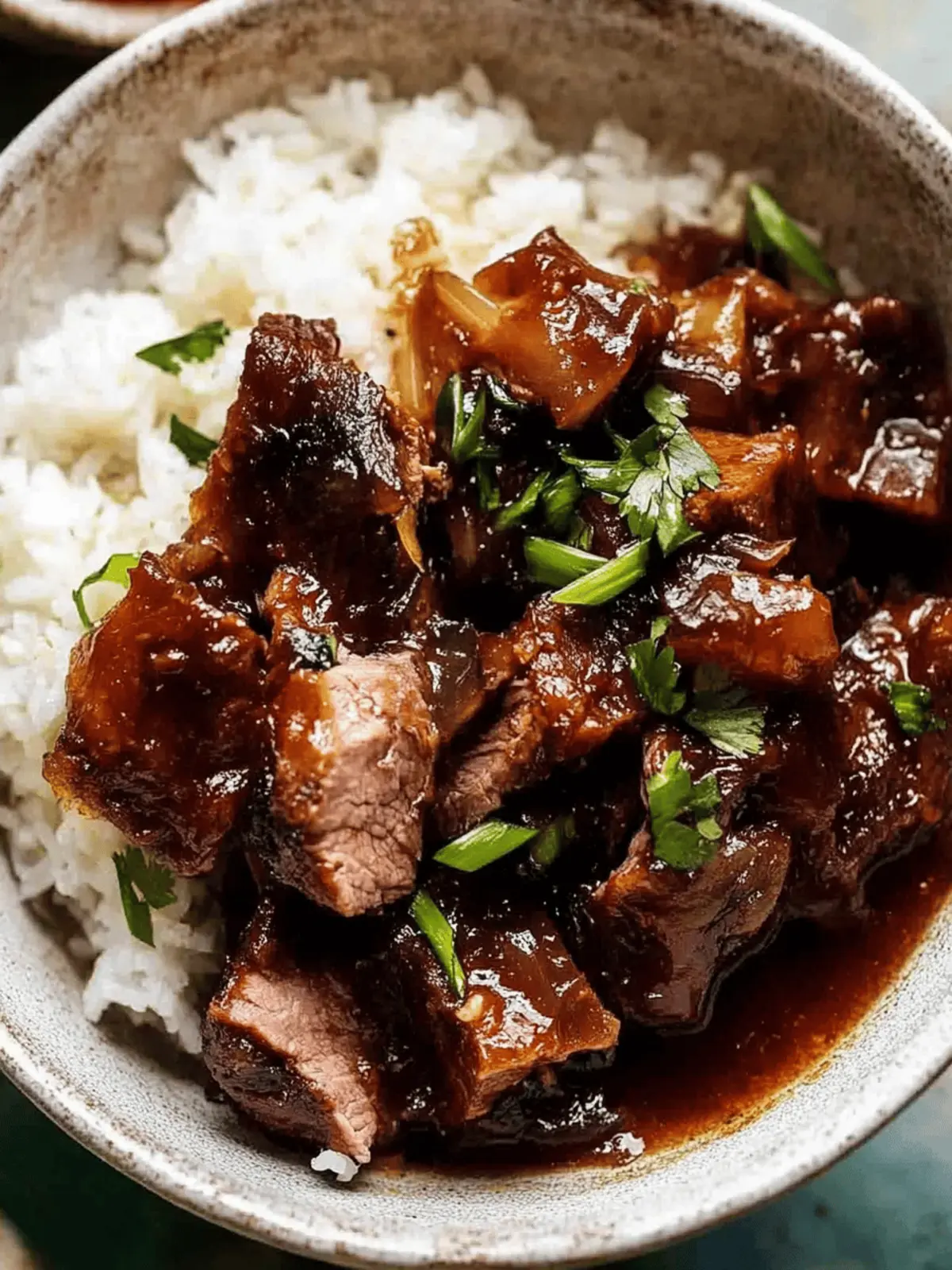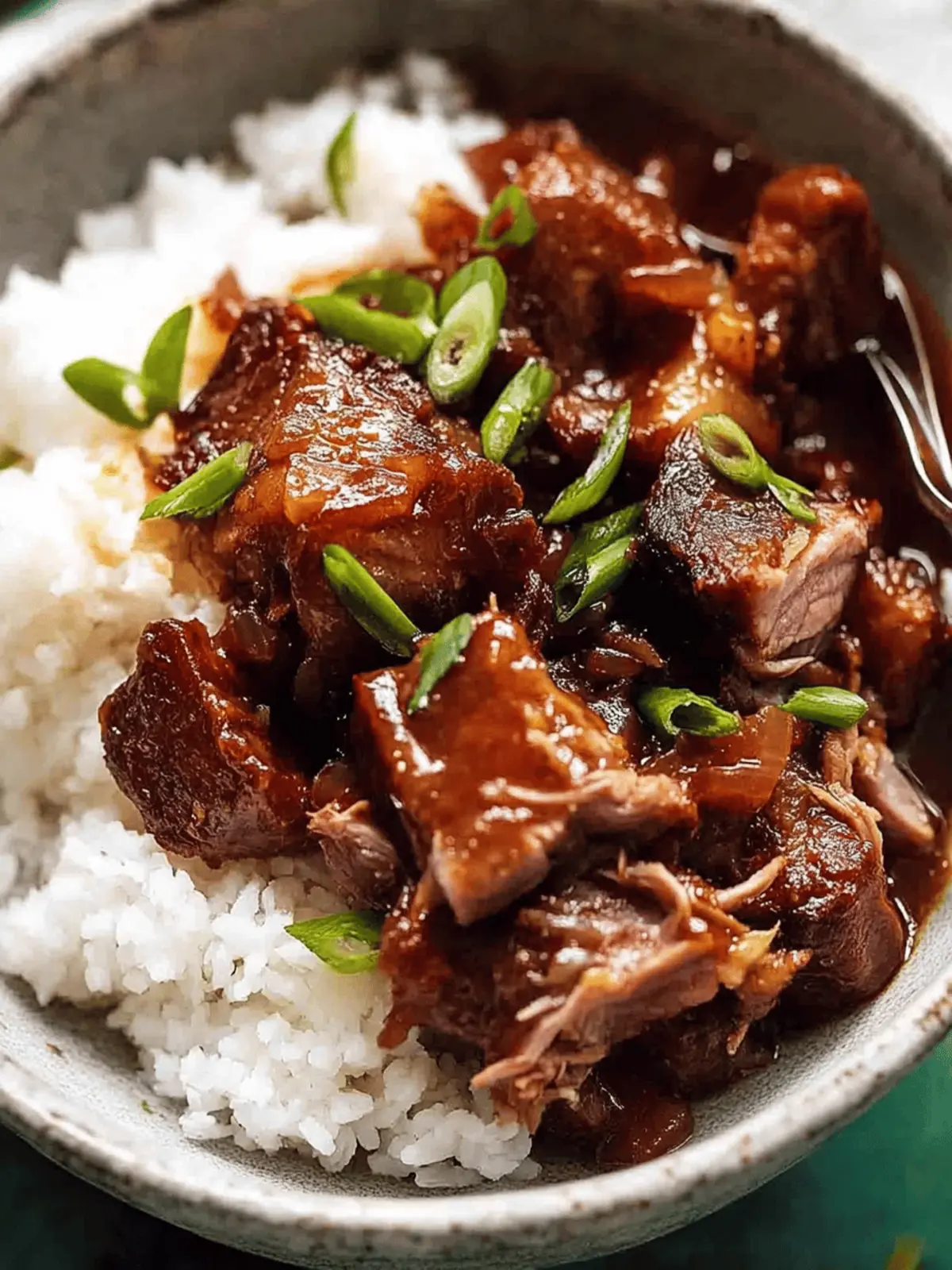As the sun begins to set and a golden hue washes over the kitchen, I find myself reminiscing about the comforting embrace of my grandmother’s Pork Adobo. The tantalizing aroma of garlic and soy sauce wafting through the air never fails to ignite a sense of nostalgia and warmth. This traditional Filipino dish is not just food; it’s a celebration of flavors that tell stories of family, heritage, and unforgettable gatherings.
In just one pot, you can immerse yourself in a savory delight that transforms modest pork into tender pieces slow-cooked to perfection. And if you’re feeling adventurous, a touch of caramelized pineapple adds a refreshing twist an unexpected burst of sweetness that contrasts beautifully with the rich, umami notes. Whether you’re seeking a satisfying weeknight dinner or a dish that will impress your guests, this Pork Adobo is a delicious solution. So grab your apron; we’re about to create a meal that’s as heartwarming as it is mouthwatering!
Why Will You Love This Filipino Pork Adobo?
Rich, Intense Flavors: Each bite offers a delightful balance of savory soy sauce, fragrant garlic, and a hint of sweetness.
One-Pot Wonder: Enjoy the simplicity of cooking everything in one vessel, making cleanup a breeze.
Nostalgic Comfort: This dish is steeped in tradition, evoking cherished family memories with every serving.
Versatile Dish: Customize with optional pineapple or switch up the protein; chicken works beautifully!
Quick Cooking: Let the slow cooker do the work while you sip tea and unwind.
Dive into a recipe that promises warmth, flavor, and unforgettable moments at your table!
Filipino Pork Adobo Ingredients
For the Pork
- Pork Shoulder – Choose well-marbled pieces for optimal tenderness; pork belly, shank, or neck are great alternatives.
- Vegetable Oil – Use any neutral oil for searing; this helps develop a rich flavor during cooking.
For the Aromatics
- Onion – Cut into wedges to release sweetness and depth; they’ll caramelize beautifully.
- Garlic – Thinly sliced for maximum flavor infusion; essential to this savory Filipino dish.
For the Sauce
- Water – Ensures the meat remains moist and tender throughout the slow cooking process.
- Light Soy Sauce – Adds umami and saltiness; can substitute with regular soy sauce if needed.
- Dark Soy Sauce – For deeper color and flavor; use sparingly for best results.
- Rice Vinegar – Provides a perfect tang to balance the dish; apple cider vinegar is a good replacement.
- Brown Sugar – Helps to counterbalance the salty and tangy flavors; white sugar or honey can be used as well.
- Black Peppercorns – Adds a hint of heat; ground black pepper can be substituted if preferred.
- Bay Leaves – Contributes a beautiful aroma; fresh leaves are ideal, but dried will suffice.
For the Optional Sweetness
- Pineapple – Adds an unexpected sweetness and visual pop; fresh or canned works wonders.
How to Make Filipino Pork Adobo
- Sear Pork: Heat vegetable oil in a large pot over high heat. Sear the pork cubes in batches for about 4 minutes until golden brown. Remove from pot and set aside to retain the delicious crust.
- Sauté Aromatics: Lower the heat and add the onions to the pot, sautéing for 2 minutes until softened. Toss in the garlic and let it cook for about 1 minute until fragrant, filling your kitchen with inviting aromas.
- Prepare Braising Liquid: Return the seared pork to the pot. Add the water, both light and dark soy sauces, rice vinegar, brown sugar, peppercorns, and bay leaves. Stir gently to combine all the ingredients.
- Slow Cook: Bring the mixture to a boil, then reduce the heat to low. Partially cover the pot and let it simmer gently for 1.5 hours or until the pork is fork-tender, absorbing all those incredible flavors.
- Caramelize Pineapple: In a separate pan, caramelize pineapple chunks over medium heat until golden, about 4 minutes per side. This step adds a lovely sweetness to your dish if you choose to include it.
- Reduce Sauce: Remove the pork with a slotted spoon, increasing the heat to high to boil the sauce until it reduces to about 1.5 cups, achieving a thick, syrupy consistency.
- Coat and Serve: Return the pork and caramelized pineapple to the sauce, stirring gently to ensure it’s well coated. Heat through and serve over a mound of jasmine rice, garnished with fresh green onions for a pop of color.
Optional: A sprinkle of sesame seeds adds both texture and an extra touch of flavor.
Exact quantities are listed in the recipe card below.
Filipino Pork Adobo Variations
Feel free to infuse your Pork Adobo with delightful twists that make this dish truly your own!
- Chicken Adobo: Swap pork for chicken thighs or drumsticks, following the same cooking method for a lighter option.
- Vinegar Swap: If you don’t have rice vinegar, use white wine or apple cider vinegar for a subtle flavor variation.
- Coconut Milk: Add a cup of coconut milk during the simmering stage for a creamy, tropical twist that enhances richness.
- Spicy Adobo: Incorporate sliced chili peppers or a dash of chili flakes for a spicy kick that complements the savory elements nicely.
- Vegetable Medley: Toss in bell peppers or potatoes alongside the pork for added texture and flavor depth during the cooking process.
- Sweet & Savory: Drizzle in a bit of honey at the end of cooking for an extra layer of sweetness that beautifully contrasts the savory soy sauce.
- Smoky Flavor: Give your dish a smoky kick by adding a bit of smoked paprika or using smoked soy sauce.
- Ginger Infusion: Sauté a few slices of fresh ginger with the garlic for an aromatic touch that enriches every bite.
Make Ahead Options
These Filipino Pork Adobo preparations are a dream for busy home cooks! You can sear the pork and prepare the braising liquid up to 24 hours in advance. Simply refrigerate the combined ingredients in an airtight container to maintain freshness. On cooking day, just transfer everything to a pot, bring it to a boil, and let it simmer until fork-tender. You can also caramelize the pineapple ahead of time, storing it in the fridge for up to 3 days. When you’re ready to serve, just reheat the pork and sauce, add the caramelized pineapple, and enjoy a meal that tastes just as delicious as when freshly made, saving you time without sacrificing flavor!
What to Serve with Pork Adobo?
Create a tantalizing dining experience with these delightful pairings that enhance your Pork Adobo.
- Jasmine Rice: The classic choice, its fluffy texture soaks up the rich sauce beautifully, providing a perfect balance to the dish.
- Garlic Fried Rice: Elevate your meal with this aromatic twist; the garlic flavor adds an extra layer of depth to your plate.
- Asian Cucumber Salad: A refreshing side that brings a crisp, tangy contrast to the savory adobo, balancing flavors while adding brightness.
- Steamed Vegetables: Broccoli or green beans add vibrant color and nutrition, complementing the dish’s richness without overwhelming it.
- Eggplant Pinakbet: A traditional Filipino vegetable dish that rounds out the meal with its umami flavors, blending wonderfully with the adobo.
- Caramelized Pineapple Dessert: If you’ve used pineapple in your adobo, consider serving caramelized slices for dessert, creating a sweet and tantalizing end note.
- Iced Tea: Pair with this refreshing beverage to cleanse the palate between bites, enhancing every savory morsel of your Pork Adobo.
- Halo-Halo: An indulgent Filipino dessert that dazzles with textures while providing a sweet finale to your comforting dinner.
Enjoy a complete dining experience where every element harmonizes with your savory Pork Adobo!
Expert Tips for Filipino Pork Adobo
- Perfect Searing: Ensure your pork is golden brown before adding braising liquid; this builds a deep, rich flavor in the Filipino Pork Adobo.
- Gentle Simmer: Keep the heat low during cooking to tenderize the meat; boiling too hard can dry out the pork rather than enhance it.
- Adjust Sweetness: If you prefer a less sweet flavor, decrease the brown sugar or omit the pineapple for a traditional taste.
- Bay Leaves Matter: Don’t skip the bay leaves; they impart a unique aroma that elevates the overall flavor profile of your Pork Adobo.
- Storage Savvy: Leftovers can be refrigerated for up to 4 days; the flavors deepen and become even more delicious on the second day!
Storage Tips for Filipino Pork Adobo
Fridge: Store leftover Pork Adobo in an airtight container for up to 4 days. The longer it sits, the richer the flavors become!
Freezer: If you want to keep it longer, freeze portions in airtight containers for up to 3 months. Make sure to label and date them for easy identification later.
Reheating: Thaw in the fridge overnight, then reheat in a pot over low heat, adding a splash of water to keep it moist. Enjoy the delightful aroma as it warms back up!
Room Temperature: Don’t leave Pork Adobo out for more than 2 hours at room temperature to ensure food safety.
Pork Adobo Recipe FAQs
How do I select the best pork for Pork Adobo?
Absolutely! When choosing pork, opt for well-marbled cuts like pork shoulder for maximum tenderness and flavor. The fat will render during cooking, making the meat melt-in-your-mouth delicious. If you can’t find shoulder, pork belly, shank, or neck are fantastic alternatives that offer their own unique textures!
How should I store leftover Pork Adobo?
Leftovers are one of the delights of this dish! Store your Pork Adobo in an airtight container in the refrigerator for up to 4 days. Just remember, the flavors only deepen and improve as it sits, so it’ll be even tastier the next day!
Can I freeze Pork Adobo?
Absolutely! You can freeze leftover portions of Pork Adobo in airtight containers or freezer bags for up to 3 months. Just be sure to label and date your containers. When you’re ready to enjoy it again, thaw it overnight in the fridge, then reheat gently over low heat, adding a splash of water if needed to keep it moist.
What should I do if my Pork Adobo sauce is too salty?
If you find your sauce too salty, don’t fret! You can dilute it with a bit of water or low-sodium broth. For every cup of sauce, try adding about a half cup of water, then simmer for a few minutes to help blend the flavors. Additionally, introducing a touch of sweetness with a little extra brown sugar can help balance things out.
Is Pork Adobo suitable for people with dietary restrictions?
Yes, if you’re concerned about dietary restrictions! Pork Adobo can be made gluten-free by using tamari instead of soy sauce and are cautious about the vinegar you choose. Those with pork allergies can substitute pork with chicken or firm tofu, maintaining the same fantastic flavors. If preparing for pets, keep them away from the dish due to ingredients like onions and garlic, which can be harmful to them.
How do I know when my Pork Adobo is done cooking?
The key is tenderness! You’ll know your Pork Adobo is done when the pork is fork-tender and easily pulls apart. After about 1.5 hours of low simmering, check for doneness. If it’s not quite there yet, give it a little more time — trust your instincts! The longer, the better for those incredible flavors to meld.

Savory Filipino Pork Adobo: Your New Comfort Food Classic
Ingredients
Equipment
Method
- Heat vegetable oil in a large pot over high heat. Sear the pork cubes in batches for about 4 minutes until golden brown. Remove from pot and set aside.
- Lower the heat and add the onions to the pot, sautéing for 2 minutes until softened. Toss in the garlic and let it cook for about 1 minute until fragrant.
- Return the seared pork to the pot. Add the water, both light and dark soy sauces, rice vinegar, brown sugar, peppercorns, and bay leaves. Stir gently to combine.
- Bring the mixture to a boil, then reduce the heat to low. Partially cover the pot and let it simmer gently for 1.5 hours or until the pork is fork-tender.
- In a separate pan, caramelize pineapple chunks over medium heat until golden, about 4 minutes per side.
- Remove the pork with a slotted spoon, increasing the heat to high to boil the sauce until it reduces to about 1.5 cups.
- Return the pork and caramelized pineapple to the sauce, stirring gently. Heat through and serve over jasmine rice, garnished with fresh green onions.








